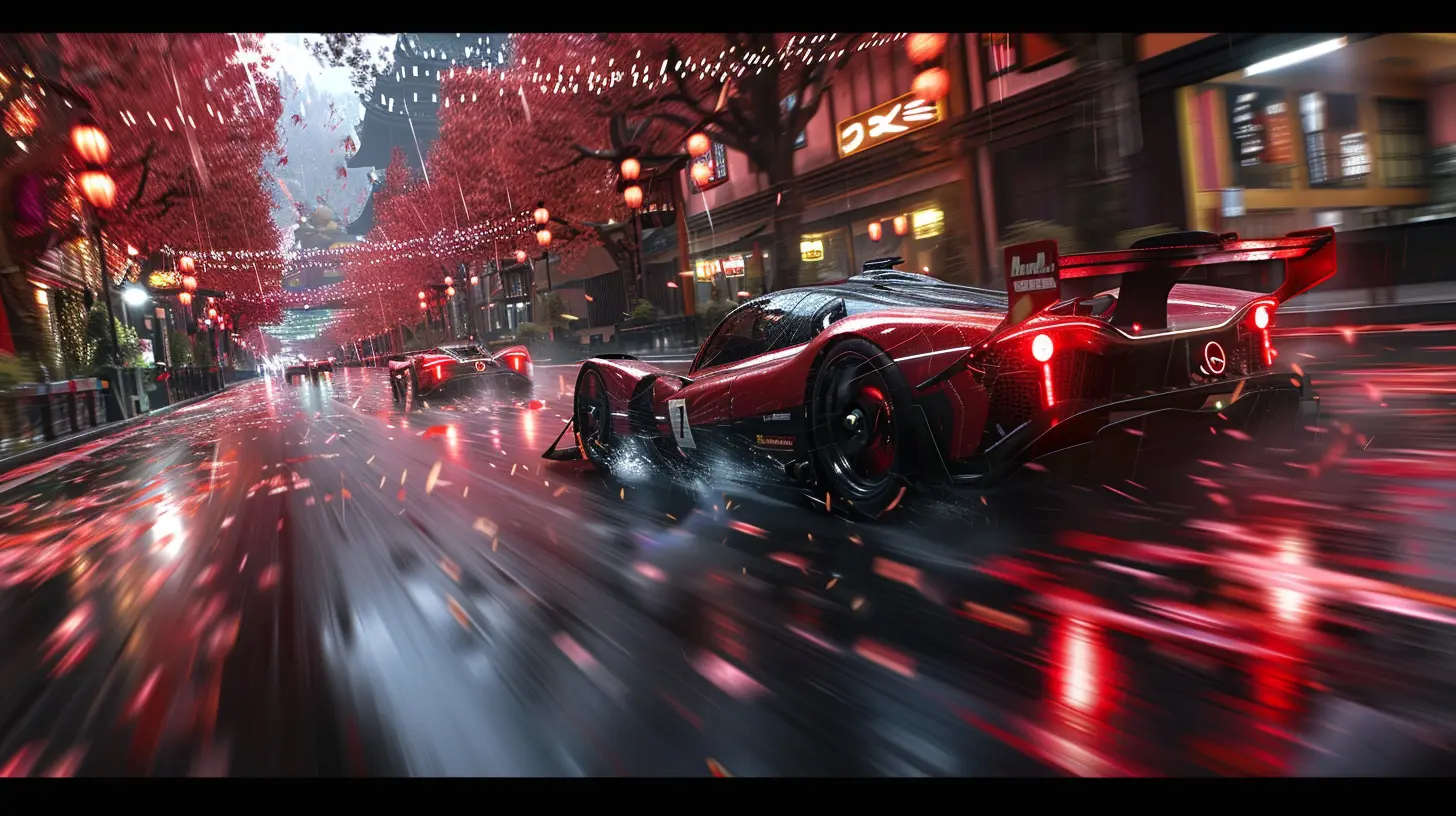How Adaptive Difficulty Changed Racing Games Forever
14 June 2025
If you're a racing game fanatic like me, you've probably had moments where a game's difficulty either made you rage-quit or breeze through tracks like you're playing bumper cars with toddlers. But then came adaptive difficulty—an under-the-hood mechanic that few players notice outright but many benefit from. It's sneaky, smart, and honestly, it's revolutionized the way we play racing games.
Let’s pop the hood on this feature and take a deep dive into how adaptive difficulty changed racing games forever.
What Is Adaptive Difficulty, Anyway?
Alright, before we go full speed ahead, let's clarify what adaptive difficulty even means.In simple terms, adaptive difficulty is a system where the game's challenge level shifts based on how you're performing. Doing well? The game makes things a bit tougher. Struggling to keep up? It tones things down. It's the gaming equivalent of a personal trainer who knows when to push you and when to let you catch your breath.
In racing games, this can take several forms—AI opponents that get faster or slower, rubber-banding mechanics, dynamic weather changes, better (or worse) rewards…the list goes on.
The Old Days: Brutally Hard or Way Too Easy
Back in the day, racing games didn’t care about your feelings. You either 'get good' or get dusted.Take the original Gran Turismo or the earlier Need for Speed titles. If you weren’t familiar with the physics or didn’t have time to memorize every track detail, you were toast. On the flip side, once you did master it, the AI remained predictable and stagnant—you’d lap them in no time.
Basically, the experience was static. It didn’t adapt to you. And this created a huge gap in the player base—hardcore players loved the challenge, but casual players bounced faster than a low-poly crash animation.
The Birth of Rubber Banding: Love It or Hate It
Cue the controversial hero of adaptive difficulty in racing: rubber banding.You know what I’m talking about—when you’re leading the race with a flawless lap, only to have the AI teleport behind you with godspeed and supernatural grip. On paper, it’s meant to keep things exciting. In practice? It feels like a cheat.
But you can’t deny its role. Rubber banding is a primitive yet effective form of adaptive difficulty. It keeps races nail-bitingly close, forcing you to stay on your toes until the last millisecond. While it’s not perfect, it was a stepping stone toward the more sophisticated systems we now have.
The Psychology Behind Adaptive Difficulty
So, why mess with difficulty at all? Why not just let players pick “Easy,” “Medium,” or “Hard” and call it a day?Because humans are weird.
We don’t just want to win; we want earned victories. Too easy, and it feels hollow. Too hard, and it’s frustrating. We crave that just-right, Goldilocks zone where the challenge bends without breaking.
Adaptive difficulty taps into this desire for flow—that magical zone where your skills are perfectly matched to the game’s challenge. When racing games hit this sweet spot, it becomes almost euphoric. Time disappears. You feel connected to the game, the car, the track. It’s poetry in motion.
And that’s exactly what developers realized. Keep players in the flow state, and they’ll stay engaged longer, come back more often, and even recommend the game to their friends.
Behind the Scenes: How Racing Games Pull It Off
Let’s get into the nitty-gritty—what tricks are racing games using to adapt difficulty without making it obvious?1. Dynamic AI Behavior
Modern racing games don’t just use one AI speed. They look at your lap times, how often you crash, how aggressive you are, and adjust the AI to make you sweat just enough. Games like Forza Motorsport and GRID have pretty sophisticated AI that learns from your habits.2. Custom Difficulty Scalers
Some games allow players to tweak individual elements—traction control, braking assists, ABS, and more—creating your own adaptive experience. F1 23, for example, lets you toggle a setting that lowers difficulty if you consistently underperform. Super subtle, super effective.3. Ghost Racing and Performance Matching
In online modes, adaptive difficulty isn't always about AI. Sometimes, it's the matchmaking system itself that pairs you with players of similar skill, or populates your race with ghosts of players whose lap times are comparable. You’re constantly challenged, and the fun never flatlines.4. Progression-Based Adjustments
Another common tactic? Adjusting difficulty based on your career progress. If you complete a bunch of races flawlessly, the next tier gets a noticeable bump in competitiveness. You’re rewarded with challenge.The Good, The Bad, and The Cheaty
Now, not every implementation of adaptive difficulty is a home run. Let’s talk about where it shines—and where it spins out.Pros:
- Keeps the game engaging, especially for players of different skill levels.- Reduces frustration for newcomers without punishing veterans.
- Encourages skill development by ramping up challenge gradually.
Cons:
- Can feel unfair if it’s too aggressive (hi, rubber banding).- Lack of transparency—some players don’t even realize it’s happening and feel cheated.
- May remove the sense of mastery, especially if wins start to feel “too easy.”
Like with any game mechanic, balance is everything. The best racing games don't just throw AI ahead of you when you're in first—they make you work for every overtake and each podium finish, all while silently reading your skill level like a mind reader.
Players React: Are We Cool with Adaptive Difficulty?
Honestly, the community is split.Some players appreciate the feature for keeping things fresh and competitive. Others want raw, unfiltered challenge—they crave that sense of improving against a consistent opponent.
But the reality is this: developers are moving toward inclusivity. The gaming industry is no longer catering only to hardcore sim racers or casual Sunday drivers. It wants everyone to have fun, and adaptive difficulty is one of the few systems that tries to bridge that gap.
And let’s be real—most players don’t even notice it unless it gets heavy-handed. When it’s done well, it’s invisible. It’s like a great stunt driver—you only notice them when something goes wrong.
Iconic Moments Where Adaptive Difficulty Made a Difference
Let’s throw it back to a few games that used adaptive difficulty to redefine genre expectations.🏁 Mario Kart Series
You might think a goofy, cartoonish racer wouldn’t be a pioneer of dynamic difficulty—but oh boy, is it ever. Mario Kart uses item-based balancing so well that it keeps races competitive regardless of skill level. Blue shells? Bullet Bills? Love it or hate it, it keeps you hooked.🏎 Forza Horizon
This open-world stunner mixes arcade and sim elements beautifully. It gives you adjustable difficulty sliders, plus the famed ‘Drivatar’ system that mimics real player styles. The difficulty subtly molds itself around you, creating a deeply personal racing experience.🏆 Gran Turismo Sport & 7
These games refined adaptive difficulty by adjusting AI aggression, tire wear, and even fuel consumption depending on how well you’re doing. It encourages strategic racing without feeling like the game is babysitting you.The Future of Racing Games: Smarter, Not Harder
Adaptive difficulty—and AI in general—is only going to get smarter.With machine learning, neural networks, and cloud-based data, racing games of the future will know you better than you know your own driving style. Imagine an AI that not only matches your pace but learns your weaknesses and adapts in real-time to exploit them. Now that is competition.
And with virtual reality (VR) and haptic feedback becoming more mainstream, adaptive mechanics could evolve beyond speed and tactics. We might see systems adjusting camera shake, audio cues, or even physical resistance in your controller to match game intensity.
Final Thoughts
Adaptive difficulty isn’t perfect, but let’s be honest—racing games are better with it. It’s like having a driving coach who knows when to push you and when to let you have a moment of glory. It helps rookies stay in the game and gives seasoned drivers a challenge that doesn’t get stale.Whether you love it, hate it, or didn’t even know it was there, adaptive difficulty changed racing games forever. And the checkered flag? It’s still miles away. We’re just getting started.
all images in this post were generated using AI tools
Category:
Racing GamesAuthor:

Francesca West
Discussion
rate this article
2 comments
Talis Lynch
Adaptive difficulty in racing games is like adding a turbo boost to your gaming experience—suddenly, even your grandmother can go from ‘slow and steady’ to ‘fast and furious!’ Pedal to the metal!
September 20, 2025 at 4:34 AM

Francesca West
Absolutely! Adaptive difficulty truly levels the playing field, making racing games accessible and thrilling for everyone, regardless of skill level. It's a game-changer!
Thane Lawrence
In the heart of speed, where engines roar, Adaptive challenge opens the door. With each turn and twist, gamers unite, A dance of skill, where no two rides are alike. Racing reborn, a symphony of delight.
June 17, 2025 at 2:53 PM

Francesca West
Thank you! You've beautifully captured the essence of adaptive difficulty in racing games—it truly elevates the experience and keeps every race fresh and exciting!


